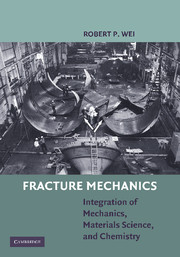Book contents
- Frontmatter
- Contents
- Preface
- Acknowledgments
- 1 Introduction
- 2 Physical Basis of Fracture Mechanics
- 3 Stress Analysis of Cracks
- 4 Experimental Determination of Fracture Toughness
- 5 Fracture Considerations for Design (Safety)
- 6 Subcritical Crack Growth: Creep-Controlled Crack Growth
- 7 Subcritical Crack Growth: Stress Corrosion Cracking and Fatigue Crack Growth (Phenomenology)
- 8 Subcritical Crack Growth: Environmentally Enhanced Crack Growth under Sustained Loads (or Stress Corrosion Cracking)
- 9 Subcritical Crack Growth: Environmentally Assisted Fatigue Crack Growth (or Corrosion Fatigue)
- 10 Science-Based Probability Modeling and Life Cycle Engineering and Management
- APPENDIX: Publications by R. P. Wei and Colleagues
- References
8 - Subcritical Crack Growth: Environmentally Enhanced Crack Growth under Sustained Loads (or Stress Corrosion Cracking)
Published online by Cambridge University Press: 05 June 2012
- Frontmatter
- Contents
- Preface
- Acknowledgments
- 1 Introduction
- 2 Physical Basis of Fracture Mechanics
- 3 Stress Analysis of Cracks
- 4 Experimental Determination of Fracture Toughness
- 5 Fracture Considerations for Design (Safety)
- 6 Subcritical Crack Growth: Creep-Controlled Crack Growth
- 7 Subcritical Crack Growth: Stress Corrosion Cracking and Fatigue Crack Growth (Phenomenology)
- 8 Subcritical Crack Growth: Environmentally Enhanced Crack Growth under Sustained Loads (or Stress Corrosion Cracking)
- 9 Subcritical Crack Growth: Environmentally Assisted Fatigue Crack Growth (or Corrosion Fatigue)
- 10 Science-Based Probability Modeling and Life Cycle Engineering and Management
- APPENDIX: Publications by R. P. Wei and Colleagues
- References
Summary
Overview
In Chapter 7, the subject of subcritical crack growth (namely, stress corrosion cracking and corrosion fatigue) was treated from a phenomenological perspective. The emphasis, by and large, is focused on the development of design data to cover a limited range of service conditions, rather than a broad-based understanding. As such, the influences of material composition and microstructure, and their interactions with the external chemical and thermal environment (e.g., atmospheric moisture and sea water) are not fully addressed. As such, the data are only of limited value, and cannot be “extrapolated” to cover other loading and environmental conditions.
In this and the next chapter, the contributions to the understanding and modeling of the effects of conjoint actions of loading, and chemical and thermal variables on a material's crack growth response are highlighted. The presentation draws principally on results from the author's laboratory. For clarity, the influences of gaseous and aqueous environments under sustained or statically applied loads (or stress corrosion cracking) are considered here. Those for fatigue crack growth are highlighted in Chapter 9. Illustrations (to a large extent constrained by the “windows of opportunity”) are drawn from research in the author's laboratory, and will cover high-strength steels in gaseous and aqueous environments, nickel-base superalloys in oxygen, and ceramics in water. For fatigue crack growth, the materials include aluminum and titanium alloys and steels. Understanding is derived through coordinated experiments and analyses that probe the underlying chemical, mechanical, and materials interactions for crack growth.
- Type
- Chapter
- Information
- Fracture MechanicsIntegration of Mechanics, Materials Science and Chemistry, pp. 120 - 157Publisher: Cambridge University PressPrint publication year: 2010



